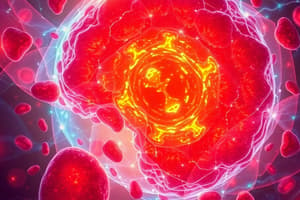Podcast
Questions and Answers
What characterizes Stage II of Burkitt's lymphoma?
What characterizes Stage II of Burkitt's lymphoma?
- Involvement of two or more lymphatic sites on the same side of the diaphragm. (correct)
- Disseminated disease with multiple extra-lymphatic sites.
- Involvement of a single lymphatic site or extra-lymphatic site.
- Involvement of two or more lymphatic sites on both sides of the diaphragm.
Which imaging technique is primarily used for assessing lymph node involvement in Burkitt's lymphoma?
Which imaging technique is primarily used for assessing lymph node involvement in Burkitt's lymphoma?
- Bone Marrow Biopsy
- CT Scans (correct)
- MRI
- Ultrasound
What does the presence of systemic symptoms indicate in the A/B classification of Burkitt's lymphoma?
What does the presence of systemic symptoms indicate in the A/B classification of Burkitt's lymphoma?
- Class B (correct)
- Stage I
- Stage III
- Stage II
Which imaging technique is particularly useful for evaluating central nervous system involvement in Burkitt's lymphoma?
Which imaging technique is particularly useful for evaluating central nervous system involvement in Burkitt's lymphoma?
What is the significance of a Bone Marrow Biopsy in the staging of Burkitt's lymphoma?
What is the significance of a Bone Marrow Biopsy in the staging of Burkitt's lymphoma?
Which stage of Burkitt's lymphoma involves disseminated disease with extra-lymphatic sites, including CNS involvement?
Which stage of Burkitt's lymphoma involves disseminated disease with extra-lymphatic sites, including CNS involvement?
Flashcards are hidden until you start studying
Study Notes
Burkitt's Lymphoma Staging
Clinical Staging
- Stage I: Involvement of a single lymphatic site or extra-lymphatic site.
- Stage II: Involvement of two or more lymphatic sites on the same side of the diaphragm or one lymphatic site with an extra-lymphatic site on the same side.
- Stage III: Involvement of lymphatic sites on both sides of the diaphragm; may include the spleen.
- Stage IV: Disseminated disease with multiple extra-lymphatic sites, including bone marrow and/or central nervous system (CNS) involvement.
- A/B Classification:
- A: Absence of systemic symptoms (fever, night sweats, weight loss).
- B: Presence of systemic symptoms.
Diagnostic Imaging
-
CT Scans:
- Primary tool for assessing lymph node involvement and abdominal masses.
- Helps to evaluate the extent of the disease and determine stage.
-
PET Scans:
- Useful for detecting active disease and assessing response to treatment.
- Provides functional imaging and can identify metabolic activity in lymph nodes and tissues.
-
MRI:
- Particularly useful for evaluating CNS involvement.
- Can help visualize masses and assess brain and spinal cord status.
-
Bone Marrow Biopsy:
- Not an imaging technique, but important for staging.
- Helps evaluate for bone marrow involvement, which is critical for determining the extent of the disease.
-
Ultrasound:
- Can be used for evaluating abdominal masses, especially in pediatric cases.
- Useful in guiding biopsies of lymph nodes or masses.
Burkitt's Lymphoma Staging
Clinical Staging
- Stage I: Involvement is limited to a single lymphatic or extra-lymphatic site.
- Stage II: Involvement includes two or more lymphatic sites on the same side of the diaphragm, or one lymphatic with an extra-lymphatic site on the same side.
- Stage III: Involves lymphatic sites on both sides of the diaphragm and may include the spleen.
- Stage IV: Characterized by widespread disease affecting multiple extra-lymphatic sites, which may include the bone marrow and/or the central nervous system (CNS).
- A/B Classification:
- A indicates no systemic symptoms are present (e.g., no fever, night sweats, or weight loss).
- B denotes the presence of systemic symptoms.
Diagnostic Imaging
- CT Scans:
- Primary imaging tool to evaluate lymph node involvement and abdominal masses.
- Essential for assessing the extent of the disease and determining the clinical stage.
- PET Scans:
- Useful for detecting active disease and monitoring treatment response.
- Provides functional imaging to identify metabolic activity within lymph nodes and tissues.
- MRI:
- Particularly effective for assessing CNS involvement, visualizing masses, and examining the status of the brain and spinal cord.
- Bone Marrow Biopsy:
- An essential procedure for staging, not an imaging technique.
- Helps determine if there is bone marrow involvement, critical for understanding disease extent.
- Ultrasound:
- Can evaluate abdominal masses, especially in pediatric cases.
- Acts as a guide for biopsies of lymph nodes or masses.
Studying That Suits You
Use AI to generate personalized quizzes and flashcards to suit your learning preferences.





